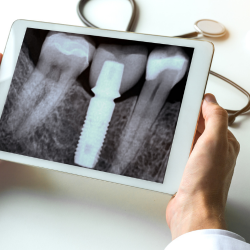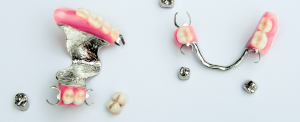The placement of dental implants is a precision procedure. Surgical guides are a tool that can help dentists locate implants more accurately, which in practice translates to a reduced risk of complications.
What is a surgical guide?

A surgical guide is a device used to guide the placement of dental implants. It is created from 3D images of the patient’s mouth, allowing the dentist to visualize the procedure with precision.
What are its benefits?
Surgical guides offer several benefits, including:
1. Greater Precision: They assist dentists in placing the implants in the exact intended position, reducing the risk of complications such as implant loss.
2. Reduced Surgical Time: Surgical time is reduced due to pre-visualization of the procedure.
3. Improved Aesthetic Results: The visual outcome is much better, resulting in a more ideal restoration from an aesthetic standpoint.
4. Reduction in Postoperative Pain and Swelling: Digital dentistry, as mentioned in previous articles, allows for guided work through 3D oral scanning. In this case, it implies a reduction in postoperative pain and swelling since the professional knows exactly what to expect and can therefore reduce the risk of subsequent complications.
How are they created?
The process of creating surgical guides consists of three phases:
1. Image Acquisition: The patient undergoes a series of 3D images, such as computed tomography (CT) scans or intraoral scans, to create a virtual model of their mouth.
2. Planning: The dentist uses the virtual model to plan the surgical procedure. In this phase, the dentist must consider factors such as the position of adjacent teeth, bone quality, and the need for other procedures like bone grafts or sinus lifts.
3. Fabrication of the Surgical Guide: The surgical guide is made from a sturdy material like plastic or metal and is custom-fitted to the patient’s mouth.
What types exist?
There are mainly two types:
1. Milling Surgical Guides: These guides are used to guide the placement of implants. They are made from a durable material that allows the surgeon to mill the bone to place the implants in the intended position.
2. Impression Surgical Guides: These guides are used to guide the placement of crowns on the implants. They are made from a softer material that enables the dentist to precisely place the crowns.
Who can use surgical guides?
They can be used by any dentist trained to place dental implants. However, it is essential for professionals using them to have specific training to avoid errors.
Concrete Data from Specialized Journals
A study published in the Journal of the American Dental Association (JADA) found that dental implants placed with surgical guides had a success rate of 97%, compared to 92% for implants placed without them. Additionally, the study found that implants placed using this method had a lower rate of complications.
Another study published in the International Journal of Oral and Maxillofacial Surgery found that patients who received dental implants placed with surgical guides were more satisfied with the results than those who received implants placed without them.
Contact us for guidance by clicking here.



